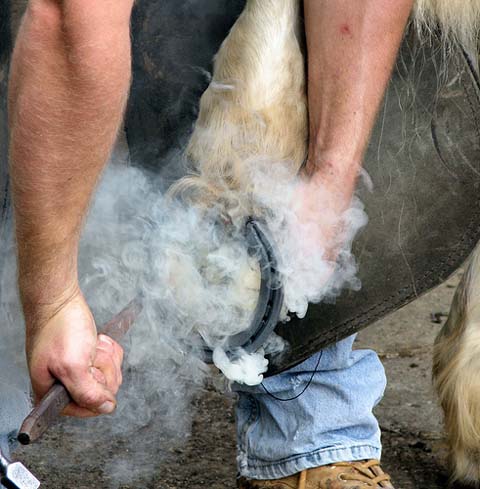
Today’s guest blog was written by Tom Stovall. He is an American Farriers Association Certified Journeyman Farrier since 1983, a Member of the Texas Professional Farriers Association, and a Member of the Artists-Blacksmiths Association of North America.
Each and every time a farrier picks up a foot, the object of the exercise is always to give the horse what it needs to do whatever it does as efficiently as possible. Purists be damned, if I can give a horse what it needs cold, cold shoeing is my method of choice because cold shoeing is easier and much faster.
Twenty-odd years ago, it was impossible to buy ready made shoes here in the States that were comparable in quality to hand mades. All of the general-use steel shoes on the market were too narrow of web, had too shallow a nail pattern, and had the heel nail located too close to the heel. As a consequence, most of the farriers who shod show horses or did much veterinary farriery had to haul around a coal forge, a sack of coal, and an inventory of bar stock in order to get their horses hung up in what they needed to have on their feet.
In the early eighties, two European manufacturers began making horseshoes that were about as well designed and made as anything most of us could forge by hand. Additionally, they came in lefts and rights and fronts and hinds, so there wasn’t a hell of a lot of fitting necessary.
The first shots of the Horseshoe Revolution had been fired and all one had to do to join in was find a supplier who sold the E-type nails for which the European shoes were punched. For a while, it was easier to get the shoes than the nails. Eventually, several North American manufacturers began making useful shoes as well, so a farrier now has a fairly wide choice of well-designed shoes from which to choose.
About the same time as the Horseshoe Revolution, a fellow named Ken Mankel started marketing a portable LP gas-fired forge. Gas forges freed farriers from coal and made it much easier to acquire forging skills (tending a coal fire is an art unto itself), but many farriers did not see any reason to hone those skills because damn near anything a horse needed could be bought at a supply house.
Occasionally, in some disciplines more than others, a horse needs something that can’t be bought or is so off-the-wall that an inventory might rust away before it’s ever applied, so I believe forging skills are still a part of a farrier’s job description. I see no reason to carry around an inventory of seldom-used shoes when they can be easily and quickly forged from bar stock if one has the requisite forging skills. A few pieces of odd-sized bar stock are a hell of a lot cheaper and easier to haul around than an inventory of #000’s and #5’s.
Many farriers with only minimal forging skills manage to give most of their horses what they need, however, most is not the same as all.
Farriers spend an inordinate amount of time cussing and discussing the tendency of the younger generation to downplay the necessity of developing forging skills, but without a system of education and formal apprenticeship, the situation is not likely to improve.
Most farriers are in agreement that hot-fitting shoes is the method of choice any time a clip(s) is involved because a burned-in clip is much superior to a cut-in clip in terms of stability. In short-footed horses, a clip that sits on top of the wall is useless.
A hot-fit shoe is more stable than one cold-fit because, assuming it’s nailed on where it was fit, the wall is an exact mirror image of the shoe.
In my experience, hot fitting is also beneficial when feet are too wet. (On the Texas Gulf, most feet are much too wet.) A hot-fit shoe sears (seals) the tubules of epithelial cells which comprise the wall at the ground surface, so hot-fitting is usually the method of choice when horses are kept under too-wet conditions. One seldom sees the “hoof hairs” indicative of keratin loss when wet feet are hot-fit on a regular basis.
As always, the hard part is figuring out what the horse needs.
If you have problems seeing the video below click HERE
.youtube::6d_Q0c3rtCY::
